The modern market provides a wide range of ventilation equipment, varied in characteristics and prices. We will help you make the right choice by introducing you to the main types, manufacturers, and reveal the secrets of manufacturing, installation and repair.
The set of ventilation equipment for the installation of the system depends on the characteristics of the object.
The following factors influence the choice of equipment:
- the purpose of the object;
- number of floors;
- the presence of hazardous emissions in the air;
- building configuration;
- scope of use;
- presence or absence of a service area.
For example, in swimming pools, the air must be dehumidified, and in other cases, on the contrary, humidified.
- Ventilation equipment manufacturers
- Household and semi-industrial equipment
- Industrial and special purpose
- Types of ventilation equipment
- The main components of the supply ventilation system
- Types of industrial equipment
- Ventilation equipment manufacturing
- Installation and installation of ventilation equipment
- Maintenance of ventilation equipment
- Repair of ventilation equipment
Ventilation equipment manufacturers
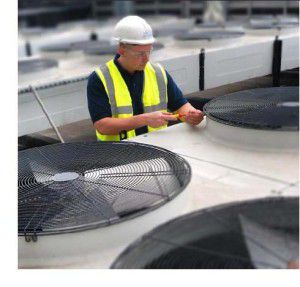
Today, Russia is supplied with ventilation equipment from all major world manufacturers, each specializing in its own segment.
Household and semi-industrial equipment
Such systems provide air exchange up to 6 thousand cubic meters of air per hour. They are installed on objects no more than 650 sq. meters.
Among others, such foreign manufacturers of ventilation equipment as: Remak (Czech Republic) Kanalfakt / Systemair (Sweden) Ostberg (Sweden), Ventrex (Europe). Russian manufacturers of ventilation equipment Korf and Arktos produce reliable, competitive products.
Monoblock installations are a separate category. This is a completely finished system, assembled in a single module with sound insulation. Monoblock systems are characterized by a wide range of prices (within 50%) compared to type-setting. Produced by their firms SHUFT, Electrolux, Aeroblock other.
Industrial and special purpose
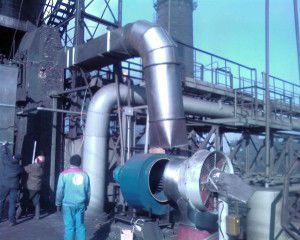
Industrial ventilation equipment serves over 400 sq. meters, providing air exchange of 4 thousand cubic meters per hour. Special-purpose systems are installed in buildings with increased microclimate requirements (operating rooms, production of medicines and electronic equipment), as well as in smoke removal and emergency air exchange systems.
The equipment of this class is supplied only on order.
The most famous and large foreign manufacturers of ventilation equipment: Wesper, Pyrox, Lennox, Clivet, VTS Clima, Remak. The largest among Russian manufacturers of industrial-grade ventilation equipment: Moven, Veza, Arktos. The characteristics of special-purpose equipment are very specific, so it is selected only for a specific object.
Types of ventilation equipment
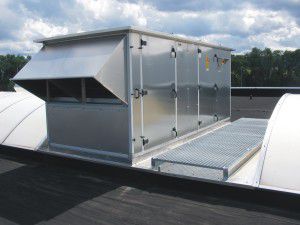
Depending on the project, household and industrial ventilation equipment can be exhaust, supply or supply and exhaust. The air handling unit can operate separately from the supply air unit or they are united by an automatic control center. Such complex schemes are used at large facilities: in shopping, sports and entertainment centers, industrial enterprises.
Conventionally, all manufactured ventilation equipment can be divided into three segments in terms of capacity:
- semi-industrial and household;
- industrial;
- "Special" purpose.
Ventilation equipment for a home or business is also divided by functionality:
- for air supply;
- to control the air supply;
- for processing (filtering, dehumidifying, heating, humidifying or cooling) air;
- to control the system.
The most common types of ventilation equipment for homes, offices and industrial facilities:
- compressor and condenser module;
- air heaters (can be electric or water);
- air coolers (water or freon);
- fans;
- recuperators;
- mufflers;
- air curtains;
- modules for aspiration and air disinfection.
Air exhaust equipment is structurally simpler. The "heart" of the exhaust system is a duct fan. A silencer and filters are installed in most cases.
During the construction of the supply system, the air must be heated and cooled; the corresponding modules are additionally installed.
The main components of the supply ventilation system
- Ventilation grilles. Through them, air enters the room from the street. They protect the system from dust, precipitation, insects. Sometimes a supply valve is installed instead of an external grill;
- Check Valve protects the system from unauthorized entry of outdoor air. In the cold season, this indispensable function helps to keep the room warm. As a rule, the valves are electrically actuated, which opens them when the fan starts up;
- Filters clean the street air from lint, dust and flies. Standard coarse filter with particles less than 10 microns. For special requirements for the supply air, finer filters with fine particles are used;
- Duct heaters used in cold weather for heating the supply air. There are water and electrical modifications. The former are preferable for large objects. Operated at an ambient temperature of -40 ... + 40 degrees. Differ in heat output. A more modern way of heating air is with a recuperator. To warm up clean air, it uses the heat of dirty air, without affecting their chemical composition in any way. The disadvantage of recuperators is their high cost;
- Fan it is one of the main components of the air exchange system.
When choosing a fan, pay attention to the performance and design pressure.
Fans can be:
- radial - create high pressure in the system;
- axial - they are characterized by low pressure at high productivity, therefore they are poor in systems with many turns, branches.
Duct fans are designed for installation directly in the lumen of air ducts.
- Silencers suppress aerodynamic hum in the system using sound-absorbing materials. They wrap the walls of ventilation ducts, fans. Silencers also reduce the noise level spreading through the air ducts;
- Air ducts - highways through which air flows through all stages of preparation to the manned room. They can be of various shapes, sizes, rigidity. Equipped with shaped parts for forming turns, branching;
- Distributors - are installed directly at the entrance to the serviced premises. They direct jets or streams of air in the right direction and with the right intensity. Distributor types: diffusers, grilles. In addition to the main task, they also perform decorative;
- Control and automation systems. Cabinet or control panel. It can be mechanical or electronic depending on the complexity of the system.
Types of industrial equipment
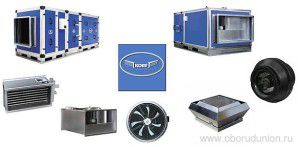
- Central air conditioners it is a type of on-line air exchange systems that serve one or more large rooms through a network of air ducts. Each of the premises maintains unique microclimate parameters. Air cooling and heating is carried out using water, electricity or steam. The air is filtered and brought to the required humidity;
- Supply units and mini-supply units filter the air, bring it to the required temperature, mix and deliver it to the room;
- Modular compact units contain blocks for filtration, cooling, heating and air mixing. They work at an ambient temperature of -40 ... + 40 degrees;
- Roof fans used for air outflow in buildings for various purposes. Withstand ambient temperatures from -30 to +40 degrees, installed outside (on the roof) of the building exclusively in a horizontal position. Installation on a sloped roof is possible.
The fans are not intended for transporting air with explosive, aggressive and abrasive inclusions.
Ventilation equipment manufacturing
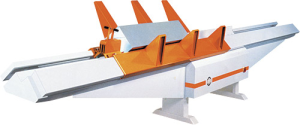
The production of ventilation equipment is a high-tech process that requires the use of precise and sophisticated equipment. The best companies have a full production cycle and their own design bureaus, which are engaged in the development of new products and the introduction of new technologies.
In the production of ventilation equipment, rather expensive machines are used. For example, the minimum cost of a machine for manufacturing a spiral-wound air duct is 50 thousand euros. And this is the simplest and most inexpensive ventilation component.
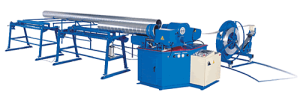
New machines and competent employees will ensure a minimum of defective products and waste with high labor productivity.
It is beneficial to have your own storage facilities for finished products and materials. After purchasing large quantities of metal, you can get a good discount from the supplier.
Video about the production of some types of ventilation equipment:
Installation and installation of ventilation equipment
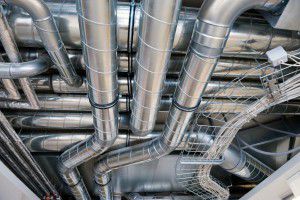
Installation of ventilation equipment is carried out in several stages:
- Study of the building's features;
- Drawing up the terms of reference;
- Project creation;
- Preparatory work;
- Installation of air ducts;
- Installation of ventilation equipment;
- Connection to electrical and other engineering networks, if necessary;
- Commissioning activities;
- Commissioning.
A designer, builder or ordinary buyer may require a certificate for ventilation equipment.
The certificate confirms the compliance of the technical parameters with the requirements of SNiP and State Standards. Certified ventilation equipment relieves the responsibility of the builder in the event of an accident.
Ventilation equipment is certified on the basis of Gosstroy and Gosstandart regulations. Safety certificates are issued only in the State Standard of the Russian Federation.
To obtain a certificate of fire and sanitary safety, you must first obtain an opinion from the relevant authorities. Only organizations accredited by the Main Directorate of the State Fire Service of the Ministry of Internal Affairs have the right to issue such certificates.
The efficiency of the future system largely depends on the correct installation of ventilation equipment. Therefore, you should not save on the services of professionals. As a rule, suppliers of ventilation equipment offer their specialists for installation work.
Maintenance of ventilation equipment
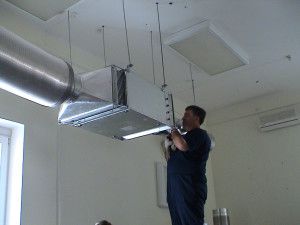
The maintenance of ventilation equipment, entrusted to experienced professionals, ensures long-term trouble-free operation.In addition, high-quality maintenance is one of the conditions for the well-being of people. Indeed, with illiterate cleaning and lack of disinfection, after a while the ventilation unit becomes a breeding ground for microbes and toxins.
Maintenance of ventilation equipment includes:
- diagnostics;
- cleaning of external and internal components;
- replacement of parts if necessary;
- disinfection of the system;
- registration of an act of work performed.
Sometimes the service package includes minor repairs of ventilation equipment. All activities, as well as the timing of the maintenance of ventilation equipment, are stipulated in a written agreement between the service company and the customer.
The price of the work depends on the diameter and length of the air ducts. As a bonus, the customer can be provided with free diagnostics and a conclusion.
Repair of ventilation equipment
Repair of ventilation equipment can be standard or major.
The list of works during a typical repair of ventilation equipment includes:
- sealing of rusted places, dents, holes in ventilation ducts and housings;
- repair of fasteners of any type (soldering, riveting, flanges, nipples), sealing fasteners with bolts with replacement of worn parts;
- repair of shaped elements with adjustment of the position and cross-section of deflectors and distributors;
- repair of ventilation chambers;
- straightening of fan blades;
- repair and balancing of the shaft and rotor;
- installation of new bearings to replace worn out ones;
- filter change, oil change, lubrication, cleaning;
- repair of air heater tubes;
- lubrication of all parts and mechanisms;
- elimination of signs of corrosion, painting;
- reduced equipment vibration and reduced hum.
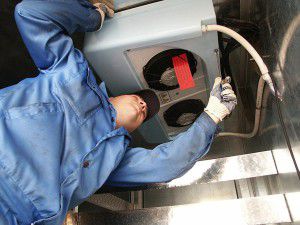
Overhaul of ventilation equipment for an enterprise, a house includes all maintenance procedures and additionally:
- replacement of the fan rotor and shaft;
- installation of new rolling bearings without fail;
- balancing the rotor on special equipment;
- restoration of thermal insulation, valves, chamber doors;
- replacement of a third or more of air ducts and fittings;
- painting the entire system;
- commissioning works.
The owners of apartments or cottages with ventilation are usually engaged in ventilation repairs on their own. We strongly advise against taking an unjustified risk, as well as resorting to the services of unverified masters "on an ad on the fence."








